Back to Journals » Advances in Medical Education and Practice » Volume 12
Electronic Health-Information Resource Utilization and Its Associated Factors among Health Professionals in Amhara Regional State Teaching Hospitals, Ethiopia
Authors Tesfa GA , Kalayou MH , Zemene W
Received 5 December 2020
Accepted for publication 15 February 2021
Published 1 March 2021 Volume 2021:12 Pages 195—202
DOI https://doi.org/10.2147/AMEP.S289212
Checked for plagiarism Yes
Review by Single anonymous peer review
Peer reviewer comments 2
Editor who approved publication: Dr Md Anwarul Azim Majumder
Getanew Aschalew Tesfa,1 Mulugeta Hayelom Kalayou,2 Wondossen Zemene2
1Department of Health Informatics, School of Public Health, Dilla University, Dila, Ethiopia; 2Department of Health Informatics, Institute of Public Health, University of Gondar, Gondar, Ethiopia
Correspondence: Getanew Aschalew Tesfa Email [email protected]
Background: With the rapid advancement and growth of computer and networking technologies, there is also significant growth in the availability and use of various types of electronic information resources. The availability of health information provides confidence for health professionals in clinical decision-making and improves practical skills and attitudes to care. Due to limited studies, the extent of health professionals’ electronic health-information resource (EHIR) utilization at specialized teaching hospitals in Amhara regional state is not known. This study aimed to assess the level of EHIRutilization and identify associated factors among health professionals at teaching hospitals in Amhara, Ethiopia.
Methods: An institution-based cross-sectional study was conducted among health professionals working at specialized teaching hospitals in Amhara from February 23 to May 10, 2020. Data were collected using a self-administered questionnaire. Descriptive analysis was used to describe the utilization of EHIRs. Bivariate and multivariate logistic regression analyses were applied to identify which factors were associated with EHIR use.
Results: A total of 383 (93.6% response rate) participants responded by completing the questionnaire, and 70.8% (271 of 383) of study participants used EHIRs. eHealth literacy (AOR 1.90, 95% CI 1.03– 3.54), Internet access (AOR 1.97, 95% CI 1.06– 3.67), computer literacy (AOR 1.9, 95% CI 1.68– 5.76), information-searching skills (AOR 1.89, 95% CI 1.05– 3.39), and computer access in the working area (AOR 2.50, 95% CI 1.55– 5.54) were factors significantly associated with utilization of EHIRs.
Conclusion: Nearly three-quarters of the health professionals utilized EHIRs. However, most reported that they encountered problems while they were using those resources. For better utilization levels, giving training in the area of electronic information-resource use, increasing awareness of health professionals about available resources, and improving Internet and computer access in each hospital are recommended.
Keywords: electronic information resources, health professionals, Ethiopia
Introduction
Health-information resources (HIRs) are the medium of communication between scientists who conduct health-care and biomedical research and health professionals who use their results in clinical practice and related purposes.1 These resources can be hard copy, digital (the Internet), and other professionals.1,2 Hard-copy sources provide information in printed format, such as books and journals. The Internet provides health professionals vast stores of information.3,4
With the rapid advancement and growth of computer and networking technologies, there has been significant growth in the availability and use of various types of electronic information resources.5 The advent of the Internet has also given rise to exponential growth of HIRs, and has provided a wider means of access to health professionals, meeting their immediate information needs.6
Among the different types of sources to obtain information, electronic HIRs (EHIRs) are one of the main resources used by health professions.7 The Internet affords health professionals unprecedented access to a huge volume of high-quality current and relevant health-care information.8,9
For health professionals, EHIRs provide the opportunity to use those resources for different purposes, such as clinical care of patients, better practices, research, literature searches, searching for patient-specific information, professional association updates, and consultation with colleagues.6,10,11
Health professionals use databases that supporting evidence-based practice. Online databases, such as Medline, Medscape, and Hinari, are rich in health-care information, of immense benefit to health-care practitioners, and are being made freely available online.9,11,12
The availability of health information provides confidence for health professionals in clinical decision-making and improves practical skills and attitudes to care.13 In developing countries, health professionals continue to lack access to basic and practical information to enable them to provide safe and effective care.13,14 In Ethiopia, more than half the health professionals (54%) encounter a problem in their work due to the presence of information limitations.15 Using EHIRs can reduce information gaps that challenge health professionals in their work, since they are readily available, easy to access, and quickly retrievable for quick health-care decision-making.7,16
Healthcare professionals need to update their knowledge and extract the information they need for practicing high-quality health-care delivery and to integrate best practices in handling and making healthcare decisions and providing services.17 The use of adequate EHIRs by health professionals will improve the level of health-care delivery and wellness of the population.17,18
In the past health, professionals relied on traditional HIRs to support their decision-making.14 This approach is time-consuming and not sufficient for every clinical question that arises at the point of care. Nowadays, there are many EHIRs that can be readily accessible at any time and everywhere through electronic devices (computers and mobile devices) to support their decision-making quickly.
Health information can play a significant role in improving health care, has been recognized for several years, and the value of health information lies in its utilization at the point of need. Utilization of available health information can prevent and reduce major health-care problems observable in every system, namely poor-quality clinical care, unknown variations in policy and practice, errors, waste, poor patient experience, overenthusiastic adoption of interventions of low value, and failure to implement interventions of high quality.18,19
A study in Saudi Arabia revealed that utilization of EHIRs was 72.7%.20 Another study conducted at Abuja in the federal medical center during 2017 on the use of EHIRs by health professionals showed that the majority of the respondents rarely used e-books, e-journals, and online databases. The mostst used resources were search engines (83.7%), followed by online nursing and African journal, with 81.6% and 69.4%, respectively.5
A study conducted in the UK showed that 81% of primary health-care staff used the Internet and 44% databases.21 A study conducted in teaching hospitals of Isfahan University of Medical Sciences showed that utilization of EHIRs was 65.4%, and among the various EHIRs, the highest usage by physicians was e-journals (36%). According to this study, physicians use electronic information resources for different purposes: obtaining new and updated information, conducting research, article production, and the need for everyday information.8
According to a study in Australia, health professionals used accessed HIRs for professional development and recommendations through the use of such search engines as Google and Yahoo.22 A study conducted in Rwanda showed utilization of EHIRs to support clinical decision-making was 80%, and 92% of respondents believed that using current Internet-based information was useful for offering better clinical care to their patients. Concerning frequently searched information, 34.8% searched for clinical procedure information and 24.8% for drug-prescription information.17
Health professionals in Nigeria mostly use Hinari And Medline, followed by electronic journal websites (23%). They use those resources mainly for clinical work and patient-care information, research, examination purposes, and general health-care information to update their knowledge, and also most perceived those EHIRs as relevant for their information needs.11
A survey conducted in western Oromia showed that about 42% of health professionals utilized EHIRs, 57.9% for getting the latest health information and 11.2% for research purposes.23
The utilization of EHIRs and associated factors among health professionals in Ethiopia is not known, because of the paucity of studies on this subject. With this limited availability of published literature on the utilization of EHIRs and associated factors among health professionals in teaching hospitals in Ethiopia, we aimed to add to the body of literature about the use of EHIRs and associated factors in Ethiopia, encouraging further studies for different user groups.
Methods
Study Design and Setting
This institution-based cross-sectional study was conducted among health professionals working at the University of Gondar Specialized Teaching Hospital, in Gondar city and Tibebe Ghion Specialized Teaching Hospital Located in Bahir Dar city from February 23 to May 10, 2020. During the study, the University of Gondar Specialized Teaching Hospital had 1,076 permanent employees and Tibebe Ghion Specialized Teaching Hospital 738. A majority were nurses (743), doctors (398), midwives (280), pharmacists (115), and laboratory technicians (118).
Ethiopia has nine regional states and two city administrations. Among the regions, Amhara is the second-largest and second–most populous region in the country. The region is bordered by the Sudan to the west and northwest and other regions of Ethiopia: Tigray to the north, Afar to the east, Benishangul-Gumuz to the west and southwest, and Oromia to the south.24
Study Procedure
The sample size of the study was determined using a single population–proportion formula by assuming 42% of health professionals utilized EHIRs23 with a 10% nonresponse rate:
where
N = estimated sample size
Za/2 = value of standard normal distribution (Z- statistic) at 95% confidence
P = single-population proportion and
d = margin of error at 5%.
Of the total study participants, 243 were selected from the University of Gondar Specialized Teaching Hospital and 166 from Tibebe Ghion Specialized Teaching Hospital. To ensure fair distribution of the total sample, stratified simple random sampling was applied for each hospital based on field of profession, and then using simple random sampling study participants were selected.
Data Collection
Data were collected using a self-administered questionnaire. It covereddemographic variables (age, sex, work experience, professional background), organizational factors (Internet access, computer access, training, IT support), behavioral factors (information searching, technical skills, computer literacy, eHealth literacy, awareness, attitude), and motivational factors (perceived usefulness and perceived use). The questionnaire explained the purpose of the study, and participation was voluntarys. For data collection, four health-information technicians and two supervisors were recruited.
Operational Definitions
Health Professionals
For the purposes of this study, health professionals were personnel who had had formal training in health and at least a diploma-level certificate.
EHIRs ere defined as material in an electronic (digital) form: e-journals, e-books, search engines, e-dictionaries, databases, and institutional repositories.
Data Processing and Analysis
A data-entry form was designed using EpiInfo version 7. Data were then exported to SPSS version 20 for further analysis.
Relevant variables were summarized in terms of descriptive frequencies to describe the study population. Data are presented using appropriate text, tables, and graphs.
To analyze the association between an individual independent variable with the dependent variable, bivariate analysis was performed, then variables with p≤0.2 on bivariate analysis progressed to multivariate logistic regression analysis to find associations between selected independent variables and the outcome variable. Finally, interpretation was based on the significant associations.
Ethics Statement
Ethics clearance was obtained from the ethical review committee of the Institute Of Public Health, University of Gondar. Written consent was obtained from each study participant. The study was conducted following the Declaration of Helsinki. Data collected were anonymized and participants’ privacy protected. All were kept confidential and used for study purposes only.
Results
Sociodemographic Characteristics of Study Participants
Of the total distributed questionnaires, 383 responses were received, for a total response rate of 93.6%. Among the participants, 239 (62.4%) were male, and mean age was 28.3±3.37 (23–47) years.
In terms of professional background, nurses numbered 158 (41.3%), doctors 94 (24.5%), midwives 54 (14.1), pharmacy technicians 30 (7.8%), laboratory technicians 24 (6.3%), and others 23 (6%). The mean length of work experience 3.6 (1–16) years (Table 1).
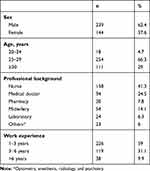 |
Table 1 Participant sociodemographic characteristics |
Awareness of Health Professionals of EHIRs
Almost all respondents were aware of Google 368, 96.1%) followed by Google Scholar 281, 73.3%), Medscape 189, 49.5%), institutional repositories 189, 49.5%), UpToDate 185 (48.4%), and Medline Plus 130 (33.8%). The major source of information on EHIRs for was friends 305, 79.8%) followed by guides 58, 15.2%) and library staff 22, 5.8%).
EHIR Utilization
Of the participants, 70.8% (271 of 383) utilized EHIRs. Search engines were the most used, followed by e-dictionaries, e-books, and e-journals (Figure 1), and 48.8% access EHIRsin their department/working area, 31.3% at home, 23% in internet cafés, and 13.8% in the library. More than half (204, 53.4%) used EHIRs to update their knowledge, followed by clinical care of patients 110, 28.8%), 55 (14.4%) for confirming clinical decisions, 53 (13.9%) for diagnoses, and 21 (5.5%) for research purposes (Table 2).
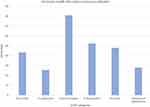 |
Figure 1 Utilization of electronic health-information resources. |
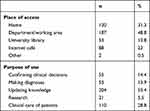 |
Table 2 Place of access and purpose of using EHIRs |
Problems Encountered Using EHIRs
In sum, 67.5% of study participants had encountered problems using EHIRs. Slow Internet connection (42.9%) was the most reported problem, followed by too much information retrieved (14.9%)and lacking information-searching skills (9.7%).
EHIR Preference
Threequarters of participants (74.93%) preferred EHIRs over other resources. The most reported reason was that EHIRs are time-saving (156, 34.3%), followed by providing more updated information (152, 33.4%), easily accessible 90 (19.8%), and providing reliable information (56, 12.3%). The other 95 (25.1%) participants did not prefer EHIRs. The commonest reason for not easily accessible (46, 48.4%), with others being difficult to use (37, 38.9%), and time-consuming (eleven, 11.6%).
Factors Associated with EHIR Utilization
To identify factors associated with EHIR utilization, bivariate and multivariate logistic regression analyses of possible predictor variables wer carried out. Variables with ORs
on bivariate analysis with p<0.2 were further considered in multivariate analysis.
Multivariate logistic regression revealed that eHealth literacy, Internet access, computer literacy, information-searching skills, and computer access in the working area were significantly associated with EHIR utilization.
Health professionals with high eHealth literacy were 1.90 times as likely to use EHIRs as those with low in eHealth literacy (AOR 1.90, 95% CI 1.03–3.54). Respondents with good computer literacy were 3.12 times as likely to utilize EHIRs as those with poor computer literacy (AOR 3.12, 95% CI 1.68–5.76).
Information-searching skills were significantly associated with EHIR use. Participants who had good technical skills in information searching were 1.89 times as likely to use EHIRs as those who had poor skills (AOR 1.89, 95% CI 1.05–3.39). Respondents with computer access were 2.50 times as likely to use EHIRs than their counterparts (AOR 2.50, 95% CI 1.55–5.54).
Health-professional EHIR utilization was also strongly associated with Internet access. Those with Internet access were 1.97 times as likely to use EHIR as those who did nots (AOR 1.97, 95% CI 1.06–3.67, Table 3).
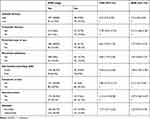 |
Table 3 Bivariate and multivariate logistic regression analysis of EHIR utilization |
Barriers to EHIR Utilization
The most frequently mentioned factors hindering EHIR utilization were lack of skill in accessing and using EHIR them (42.22%), followed by preferring print sources (36.67%), lack of awareness about electronic resources (11.11%), and lack of time to explore and locate EHIRs (8.89%, Figure 2).
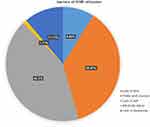 |
Figure 2 Barriers to electronic health-information resource utilization. |
Discussion
This study revealed that 70.8% of the health professionals utilized EHIRs, which is consistent with a study conducted in Saudi Arabia (72.7%),20 and one in Iran (65.4%).8 On the other hand, this result is lower than a study conducted in the UK (81%),21 one in Rwanda (80%),17 and another in Osun state, Nigeria (82.2%).25 IT infrastructure has a key role in EHIR use,so this discrepancy might be due to differences in IT infrastructure among those study settings. Another possible reason might be difference in the awareness of EHIR, and increasing awareness is needed. However, utilization of EHIRs in this study was higher than a study done in western Oromia (42%).23 This discrepancy might be due to difference in study settings, eg, nongovernmental and primary hospitals. Another possible explanation could be the difference in study period, which was conducted 4 years prior. There has been growth in information communication–technology infrastructure and an increase in accessibility of EHIRs through time.
Among those that used EHIRs, their main reasonswere updating their knowledge (53.4%), clinical care of patients (28.8%), and supporting clinical decisions (14.4%). This result is in some context supported by the study conducted in the teaching hospitals of Isfahan University of Medical Science (health professionals used EHIRs to obtain new and updated information, supporting patients, and conducting research),8 another conducted in Rwanda (used for supporting clinical decision-making, 34.8% for clinical procedure information),17 and one in Nigeria (used for accessing patient-care information, research purposes, examination purposes, general health-care information, and to update knowledge).11
In this study, the highest used EHIR was search engines. This result is in line with the study conducted in Saudi Arabia, which found that 83.7% of health professionals utilized search engines,20 and one in Australia.22 This might be due to search engines being freely available on the Internet, most of the popular databases and journals requiring subscriptions before they can be accessed, and needing to know a specific web address or password for logging in. However, studies in Nigeria,teaching hospitals of Isfahan University of Medical Sciences, and Osun revealed that among the various EHIRs, electronic databases were most used, followed by electronic journals.8,11,25 A possible explanation for this discrepancy might be due to difference in awareness among health professions regarding EHIRs.
The findings of this study showed that 67.5% of participants faced problems in using EHIRs. This is supported by a study done in Chandigarh (68.8%), and the major problems were lack of time, slow Internet speed, lack of awareness, and information overload.20
eHealth literacy, computer access, technical information-searching skills, Internet access, and computer literacy were associated with the utilization of EHIRs. eHealth literacy was significantly associated with EHIR use (AOR 1.90, 95% CI 1.03–3.54). This finding is supported by a study conducted in Bangladesh.26
Our analysis indicated that study participants who had good technical skills in information searching were 1.89 times as likely to use EHIR as those with poor information-searching skills (AOR 1.89, 95% CI 1.05–3.39). This result is in line with a study done in Karnataka12 andone in Nigeria.11 The possible explanation for this might be to the requirement of adequate information-searching skills to retrieve information on different electronic sources, especially databases that require skill to retrieve them efficiently. Another reason might be that those with good technical skills are more receptive to technology.
Participants who had computer access in their working area were 2.50 times as likely to utilize EHIRs as those who did not (AOR 2.50, 95% CI 1.55–5.54). This is comparable with a study conducted in Greece.10 This could be due to technological infrastructure being a key requirement for the utilization of EHIRs and the need for electronic devices for accessing them. Respondents who had Internet access were 1.97 times as likely to use EHIRs as those who did not (AOR 1.97, 95% CI 1.06–3.67). This is in line with the study done in Karnataka.12 The possible reason might be that most EHIRs can only be accessed online and require network connectivity.
Respondents with good computer literacy were 3.12 times as likely to use EHIR as those with poor computer literacy (AOR 1.9, 95% CI 1.68–5.76). This result is supported by the study conducted in western Oromia.23
Conclusion
Nearly three-quarters of the health professionals utilized EHIRs. However, most participants encountered problems, such as lack of information-searching skills, the volume of information retrieved, and slow Internet connection, while they use EHIRs, and a majority of participants need training in searching literature, Internet sites for medical information, accessing free full-text e-journals through Hinari, and downloading textbooks and sources for best clinical evidence for patient care.
eHealth literacy, computer access, computer literacy, information-searching skills, and Internet access were factors significantly associated with EHIR utilization. To improve utilization of EHIRs, the following suggestions are put forward.
- The hospital management should expand IT infrastructure, such as Internet and computer access in the hospital to cover each ward/department and improve Internet speed in each hospital. Nearly two-thirds of study participants face problems in using EHIRs, so it is recommended that training for health professionals regarding EHIR utilization be provided.
- The library management should distribute a list of available EHIRs to health professionals to improve their awareness of those sources for better utilization.
Data Sharing Statement
The data will be available upon request to the corresponding author.
Acknowledgment
We would like to thank the study participants for their willingness to participate in the study. The authors’ acknowledgments also extend to the data collectors and supervisors for their valuable activity.
Author Contributions
All authors made substantial contributions to conception and design, acquisition of data, or analysis and interpretation of data, took part in drafting the article or revising it critically for important intellectual content, gave final approval to the version to be published, and agree to be accountable for all aspects of the work.
Disclosure
The authors have declared that no competing interests exist in this work.
References
1. Nwafor-Orizu OE, Onwudinjo OT. Availability and use of health information resources by doctors in teaching hospitals in southeast Nigeria. Inf Knowl Manag. 2015;5(9):102–108.
2. Ruppel EK, Rains SA. Information sources and the health information-seeking process: an application and extension of channel complementarity theory. Commun Monogr. 2012;79(3):385–405. doi:10.1080/03637751.2012.697627
3. Chakroborty S. Use of the internet and electronic resources for medical science information in Bangladesh: a case study. Learn Community. 2014;5(2and3):119–128. doi:10.5958/2231-458X.2014.00014.1
4. Laki DG. Factors influencing health information-seeking behavior among health care providers at health facilities in Tanga Region: a case study of muhef project. Univers J Public Health. 2016;4(6):279–297.
5. Okiki OC, Asiru S. Use of electronic information sources by postgraduate students in Nigeria: influencing factors. 2011. Available from: http://ir.unilag.edu.ng:8080/xmlui/handle/123456789/502.
6. Oriogu CD, Subair RE, Oriogu-Ogbuiyi DC. Use of internet health information resources and information-seeking behavior among health professionals in federal medical center, Abuja. Libr Philos Pract. 2017;2017(1).
7. Gravatt Z, Arroll B. What resources do Auckland general practitioners use for answering immediate clinical questions and for lifelong learning? J Prim Health Care. 2010;2(2):100–104. doi:10.1071/HC10100
8. Papi A, Ghazavi R, Moradi S. Determining the level of awareness of the physicians in using the variety of electronic information resources and the effecting factors. J Educ Health Promot. 2015;4:49.
9. Ajuwon GA. Internet accessibility and use of online health information resources by doctors in training healthcare institutions in Nigeria. 2015. Available from: http://digitalcommons.unl.edu/libphilprac/1258.
10. Lialiou P, Mantas J. Online information seeking behaviour by nurses and physicians: a Cross-Sectional Study. Nurs Inform. 2016:33–37.
11. Adesoye AE, Amusa OI. Use of electronic resources in health sciences institutions in Ogun State, Nigeria. PNLA Quarterly. 2013;77(3):28–41.
12. Anasuya V. Usage of electronic resources by the medical, dental and paramedical science professionals in Karnataka. DESIDOC J Libr Inf Technol. 2017;37(3):158–164.
13. Pakenham-Walsh N, Bukachi F. Information needs of health care workers in developing countries: a literature review with a focus on Africa. Hum Resour Health. 2009;7(1):1–13.
14. Abbas AD, Abubakar AM, Omeiza B, Minoza K. Information-seeking behavior and computer literacy among resident doctors in Maiduguri, Nigeria. Ann Afr Med. 2013;12(2):115–119.
15. Andualem M, Kebede G, Kumie A. Information needs and seeking behavior among health professionals working at public hospital and health centers in Bahir Dar, Ethiopia. BMC Health Serv Res. 2013;13(1):534.
16. Sarbaz M, Kimiafar K, Sheikhtaheri A, Taherzadeh Z, Eslami S. Nurses’ information seeking behavior for clinical practice: a case study in a developing country. Nurs Inform. 2016:23–27.
17. Nzabonimana E, Isyagi MM, Njunwa KJ, Hackley DM, Razzaque MS. Use of an online medical database for clinical decision-making processes: assessment of knowledge, attitude, and practice of oral health care providers. Adv Med Educ Pract. 2019;10:461.
18. Brice A, Muir Gray J. What is the role of the librarian in 21st-century healthcare? Health Info Libr J. 2004;21(2):81–83.
19. Ahmad S, Dar BA, Basharat M. Usage and perception of E-resources by undergraduate students: a case study of government degree college baramulla-J&K. Libr Philos Pract. 2019;1–14.
20. Sohal GS. Use of E-resources by health professionals: a case study of postgraduate institute of medical education and research library, Chandigarh.
21. Doney L, Barlow H, West J. Use of libraries and electronic information resources by primary care staff: outcomes from a survey. Health Info Libr J. 2005;22(3):182–188.
22. Usher W. Developing policies for e-health: use of online health information by Australian health professionals and their patients. Health Inf Manag J. 2011;40(2):15–22.
23. Samuel S, Bayissa G, Asaminewu S, Alaro T. Electronic information sources access and use for healthcare services in governmental and non-governmental hospitals of western Oromia, Ethiopia: a cross-sectional study. Ethiop J Health Sci. 2016;26(4):341–350.
24. Amhara regional state. Available from: https://en.wikipedia.org/wiki/Amhara_Region.
25. Shabi IN, Shabi OM, Akewukereke MA, Udofia EP. Physicians utilization of internet medical databases at the tertiary health institutions in Osun State, South West, Nigeria. Health Info Libr J. 2011;28(4):313–320.
26. Islama MM, Touraya M, Yangb HC, Polyc TN. E-Health literacy and health information-seeking behavior among university students in Bangladesh. 2017.
 © 2021 The Author(s). This work is published and licensed by Dove Medical Press Limited. The full terms of this license are available at https://www.dovepress.com/terms.php and incorporate the Creative Commons Attribution - Non Commercial (unported, v3.0) License.
By accessing the work you hereby accept the Terms. Non-commercial uses of the work are permitted without any further permission from Dove Medical Press Limited, provided the work is properly attributed. For permission for commercial use of this work, please see paragraphs 4.2 and 5 of our Terms.
© 2021 The Author(s). This work is published and licensed by Dove Medical Press Limited. The full terms of this license are available at https://www.dovepress.com/terms.php and incorporate the Creative Commons Attribution - Non Commercial (unported, v3.0) License.
By accessing the work you hereby accept the Terms. Non-commercial uses of the work are permitted without any further permission from Dove Medical Press Limited, provided the work is properly attributed. For permission for commercial use of this work, please see paragraphs 4.2 and 5 of our Terms.


